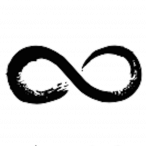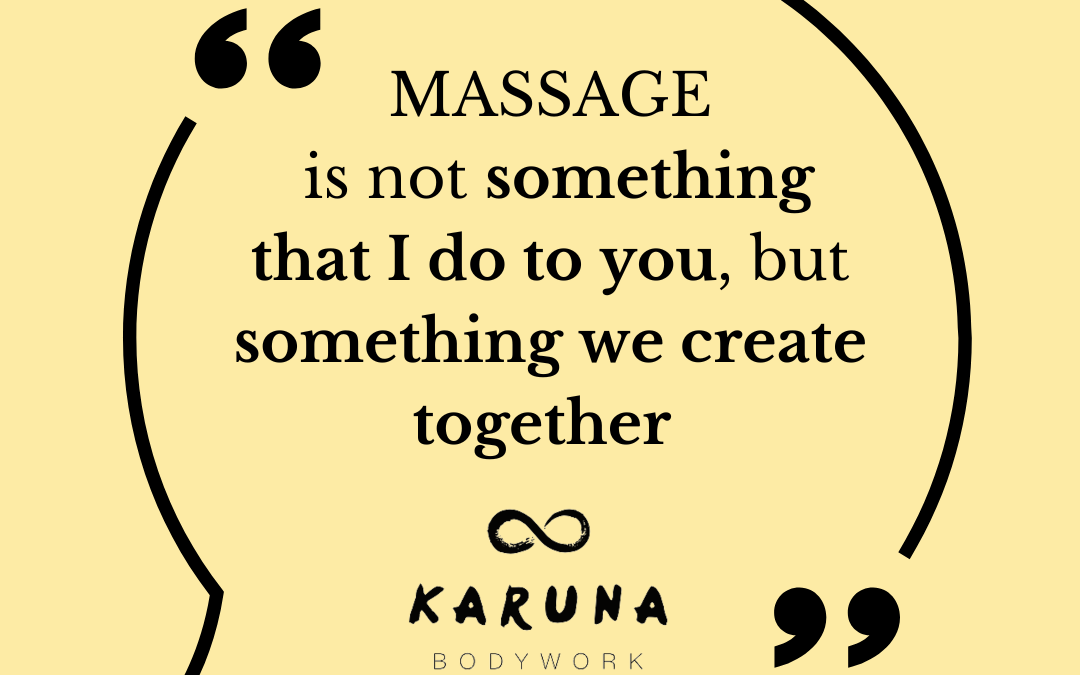EACH MASSAGE SESSION IS A CO-CREATION. WHAT DO I MEAN BY THAT?
The main ingredient of massage is touch. Of course there are other important components such as: proper technique, ergonomics, knowledge of anatomy, etc. But, to be honest, I’ve received great massages from people who were beginners or aficionados without much knowledge of technique, anatomy, etc. On the other hand, I’ve received terrible massages from people who did possess a lot of knowledge and experience. So what’s the secret, then? It is all about the quality of touch.
Touch is a way of communicating, whether we are aware of it or not. The more we are aware of what exactly we are trying to convey, the more precise our touch will be and the easier it will be to bring our message across. In my mindful touch workshops I always address the topic of touch as a means of communication, and massage is a very refined form of it!
Now, as you know, for communication to take place we need a series of elements such as: sender, receiver, message, channel, context, encoding and decoding, feedback, etc. Then we may run across unplanned or undesired elements that may interfere with the communication: what we call noise.
In our massage example, every time we touch we should know what kind of message we’re trying to convey: are we offering support, giving pleasurable sensations, calming the nervous system, looking for overall relaxation, bringing awareness to forgotten spots, encouraging the release of emotions, promoting the flow of fluids or energy, listening to subtle movements and shifts in the system, mobilizing limbs or organs, improving overall suppleness, or trying to create precise changes in the tissues and their relationships? Our touch should adapt to each of these goals!
Continuing with our analogy, we could say that the channel for our message will be mainly physical touch, and we could go on analyzing the rest of the elements, but they seem to be rather intuitive, aren’t they?
There is a catch to this, though! You have probably come across the terms „giver” and „receiver” for the participants of the massage session. If we bring these into our communication analogy, we can think of „sender” and „receiver”. The question is: who is the sender and who is the receiver? Both are!
While the massage therapist is definitely sending a message through their touch, they should at the same time be tuning into all the subtle or not so subtle messages the other person is sending all the time through different channels (tactile, visual, auditory, maybe even energetic or synesthetic), mostly without being aware of this. They should be able to perceive and interpret such „messages” as: suppleness or stiffness in the tissues, mobility or lack thereof; jerky movements, shaking, tremors; sudden hardening of a muscle in what could be a protective response; sudden relaxation of a muscle letting go; sweatiness; uneasiness, looking around, need to chatter; changes in muscle tone, cardiac rhythm, breath and general state of the nervous system; fluttering of the eyelids and movements of the eyeballs; gliding of the fascia; sounds such as sighs, moans, snoring, but also words or shouts; facial expressions; voluntary or involuntary movements of the hands and feet; reactions that might indicate activation of trauma, such as freezing; rumbling and growling in the abdomen; drooling; etc.
The fact that tactile sensations often bypass conscious interpretation (and the fact that it is not easy for some to keep their focus throughout the session) may create a lot of interference („noise”) in the communication and therefore calls for enhanced attention and sensitivity.
Massage is a wonderful example of multidimensional communication in which both participants are simultaneously „senders” and „receivers”, and we would do well to be mindful of this!
A good massage will always rely on this feedback loop, and only a therapist’s listening hands can readily react and adapt to it.
This is why I often say that massage is not „something that I do to you”, but „something we create together”.
Unfortunately this is often not the case: our culture doesn’t emphasize listening (be it with your ears or with your hands) or feeling (with your sense organs or with your heart). Western culture is all about reason and acting / reacting. In most massage schools students are taught to repeat a pattern which is applied to people with different bodies, needs and possibilities, while the truth is that people’s needs vary a lot not only from person to person, but even in the same person from day to day and hour to hour! Also the therapists’ needs and possibilities are not always the same!
Therefore massage is always a co-creation, a conversation, even a dance, if you will, albeit an improvised one, without a pre-established choreography (similar to contact improvisation). What comes out of it always depends on the encounter of two people, their current needs and possibilities, their context and the relationship they manage to create and develop throughout their interaction.
In our massage courses we teach techniques, of course, because they are necessary… and fun!. But we also focus on the qualities of what good touch should be in a massage context:
-
-
- -how to listen with your hands and how to explore and understand the receiver’s needs
- -how to touch in a way that reaches the right spot and depth and is easily accepted
- -what techniques to apply according to such needs and how to make them as precise as possible
- -how to enter the tissues with gentleness and firmness simultaneously
- -how to reach physical and energetic depth
- -how to react and adapt to the subtle signals from the body
- -how to develop and trust your intuition
- -… and more!
-
If you have enjoyed this text, you are welcome to leave a comment below.



Dziękuję za ten tekst. Słuchajmy siebie nawzajem! Dbajmy o sobie jako terapeuci, by z większą wrażliwością i otwartością podchodzić do drugiego człowieka 💗
Dziękuję za Twój komentarz, Celina! Cieszę się, że nie jestem osamotniony w swoim podejściu do masażu. Pozdrawiam serdecznie!
Świadomość, jaki rodzaj wiadomości staramy się przekazać dotykiem.
I odbieranie podświadomych sygnałów od masowanej osoby.
Dziękuję za ujęcie tematu.